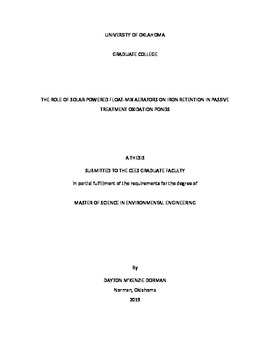| dc.description.abstract | In passive treatment of net-alkaline mine drainage, oxidation ponds are typically the primary process unit designed to promote iron oxidation, hydrolysis, and precipitation. Iron oxidation kinetics can be accelerated by supplemental aeration. Aeration in passive treatment of mine drainage is commonly achieved by the dissipation of energy from hydraulic head. However, this type of aeration is not feasible for sites located in regions with limited topographic relief. This study investigated the effectiveness of custom-designed float-mix aerators (FMAs) to increase dissolved oxygen (DO) concentrations, degas carbon dioxide(CO2) and promote iron (Fe) retention from multiple perspectives: (1) with respect to depth in the water column, (2) spatially with respect to the aerator, and (3) spatially within the oxidation pond including the overall effect of aeration on the performance of the oxidation pond. This study was conducted in the oxidation pond of the Southeast Commerce Passive Treatment System at the Tar Creek Superfund Site, the Oklahoma portion of the Tri-State Lead-Zinc Mining District. The study found: (1) The FMAs statistically increased DO saturation and raised pH at depths of 0.4 meters below the surface and shallower. No statistical difference was seen in pCO2 at any depth with active aeration. The increase in DO and pH promoted Fe oxidation. When the aerators were on, lower total Fe concentrations were found in the shallower reaches of the water column and higher total Fe concentrations were found at depth compared to the FMAs off. Similarly, a larger fraction of the Fe present was in the particulate form indicating that more Fe was oxidized and precipitated and began to settle at increasing depths. (2) The FMAs were able to increase DO saturation up to 9 m downstream compared to solely passive aeration. The FMAs, however, had a more limited radius of influence with regard to degassing CO2 and raising pH at approximately 3 m from the FMAs. The increased DO and pH provided by the FMAs allowed for more Fe to be oxidized resulting in lower total Fe concentrations downstream of the FMAs compared to when the FMAs were off. (3) Data comparing influent water quality data to effluent water quality of the oxidation pond shows that the oxidation pond, when the FMAs are on, increases DO saturation over 100%, degasses CO2, and removes an average 93% of the Fe loading before the water enters the surface flow wetland. Active aeration increased the Fe removal rate of the oxidation pond by 17% from 22 g m-2 d-1 without the FMAs to 26 g m-2 d-1 with the FMAs on. This study shows that FMAs are a viable aeration technology for sites where gravitational energy-driven aeration is not feasible due to topographic limitations. The results of this study can help optimize the design and placement of the FMAs to further improve the performance of oxidation units. | en_US |
